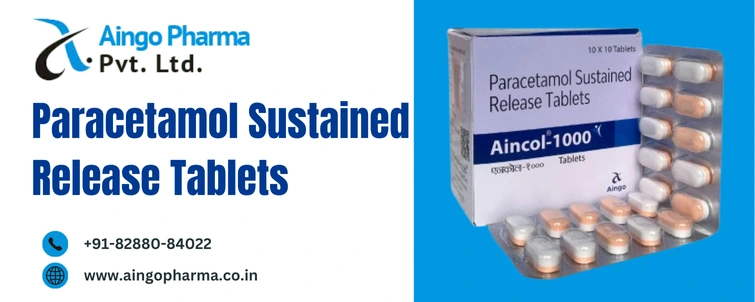



Paracetamol Sustained Release Tablets are widely used to provide effective and long-lasting relief from pain and fever. Unlike traditional paracetamol tablets that release the medication all at once, sustained release tablets are designed to release paracetamol gradually over time. This ensures a prolonged therapeutic effect, making them ideal for managing conditions that require consistent pain relief, such as chronic pain, arthritis, and post-operative discomfort.
In this blog, we will explore the uses, benefits, and advantages of Paracetamol Sustained Release Tablets, how they differ from regular paracetamol, and when they are most commonly prescribed. We’ll also answer frequently asked questions (FAQs) about the safe and effective use of this medication.

Paracetamol Sustained Release Tablets (AINCOLR-1000)are an advanced formulation of paracetamol (also known as acetaminophen) that provides extended pain relief over a longer period. The key feature of sustained release tablets is that they are designed to dissolve slowly in the body, ensuring a controlled release of the medication. This gradual release helps maintain consistent blood levels of paracetamol, providing longer-lasting relief from pain and fever.
Sustained Release (SR): A controlled-release mechanism that allows the drug to be released slowly over several hours, offering prolonged therapeutic effects without the need for frequent dosing.
Paracetamol: A well-known over-the-counter analgesic (pain reliever) and antipyretic (fever reducer), commonly used to treat mild to moderate pain and reduce fever.
The primary benefit of This Tablets is their ability to provide prolonged pain relief. Unlike regular paracetamol, which typically lasts 4-6 hours, sustained release tablets work for up to 8-12 hours. This extended duration is particularly beneficial for individuals who need consistent pain management, such as those suffering from chronic conditions like arthritis, lower back pain, or post-operative pain.
With sustained release tablets, patients need to take fewer doses throughout the day. This is especially advantageous for individuals with busy schedules or those who struggle with remembering to take multiple doses. Instead of taking paracetamol every 4-6 hours, one or two doses of sustained release tablets can provide relief for the entire day.
In addition to pain relief, paracetamol is widely used to reduce fever. This tablets maintain steady blood levels of the drug, ensuring effective fever control for longer periods. This is particularly useful for treating fevers associated with infections such as the flu, colds, or other viral illnesses.
Regular paracetamol tablets cause a rapid increase in drug concentration in the bloodstream, followed by a decline as the medication wears off. This fluctuation can lead to inconsistent relief. Sustained release tablets, however, provide a more even and stable drug concentration, minimizing the risk of the “peaks and troughs” associated with regular dosing. This results in more consistent pain management and better control over symptoms.
By delivering paracetamol more steadily into the bloodstream, sustained release tablets can reduce the likelihood of certain side effects associated with higher peaks of drug concentration. These side effects may include nausea, gastrointestinal discomfort, or liver strain (when taken in excessive doses). While paracetamol is generally considered safe, the sustained release formulation helps further minimize potential risks.
These Tablets are used to treat a variety of conditions that require prolonged pain relief or fever reduction. Some of the most common uses include:
This Tablets should be taken exactly as prescribed by your doctor or healthcare provider. The dosage and frequency will depend on the severity of the pain or fever and the individual’s medical condition.
Paracetamol is generally well-tolerated when used as directed. However, some individuals may experience mild side effects, including:
In rare cases, excessive use of paracetamol or exceeding the recommended dose can lead to liver damage. Symptoms of liver problems include jaundice (yellowing of the skin or eyes), fatigue, and dark urine. If any of these symptoms occur, it is important to seek medical attention immediately.
Before taking Paracetamol Sustained Release Tablets, consider the following precautions:
Paracetamol Sustained Release Tablets offer a convenient and effective solution for managing chronic pain and fever. With their extended-release formula, they provide long-lasting relief, reducing the need for frequent dosing and helping patients maintain consistent symptom control throughout the day. Whether you’re dealing with arthritis, post-operative pain, or fever, sustained release paracetamol can help ensure that you receive steady, reliable relief.

In conclusion, Contact Aingo Pharma if you want to know regarding Paracetamol Sustained Release TabletsTherefore, Below are our contact details.